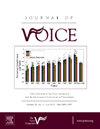Semi-occluded Nasal Tract Exercises (SONTEs): Nasal Tube in Water Exercises Using Nasal Consonants
IF 2.5
4区 医学
Q1 AUDIOLOGY & SPEECH-LANGUAGE PATHOLOGY
引用次数: 0
Abstract
Objective
This study analyzes the effects of the vocal exercises called semi-occluded nasal tract exercises (SONTEs), which were carried out with a new appliance that extends the nasal cavity as a part of the vocal tract. The acoustic, aerodynamic and electroglottographic (EGG) measurements were compared with those of the traditional semi-occluded vocal tract exercises (SOVTEs) of phonation in water.
Methods
In this study, 34 women were randomly asked to perform phonation in water for 5 min through the nasal and oral routes with the sounds /m/ and /ɔ/, respectively, using a tube with a submersion depth of 5 cm. The acoustic, aerodynamic and EGG measurements before and after the exercises were analyzed using the appropriate statistical methods.
Results
No significant difference was found in the time and frequency domain parameters before and after the exercises, except for the amplitude perturbation quotient (APQ) values, which decreased after both exercises. In addition, there was no significant difference in any aerodynamic parameters before and after the exercises, but the mean SPL values significantly increased after both exercises. The oral and nasal peak inspiratory flow rates increased after both exercises, but the increase peaked after the SONTEs implementation. As expected, the EGG–jitter and EGG–periodicity values had a reciprocal interaction with each other, while differences were observed between the values of the vocal fold movements measured in both exercises.
Conclusions
SONTEs may be as effective as the conventional SOVTEs because it made tube phonation into water possible through artificial extension of the nasal cavity and increased the resonant effect by using the positive effects based on the principles of SOVTEs.
半闭塞鼻道练习 (SONTE):使用鼻辅音的水中鼻管练习。
研究目的本研究分析了半闭合鼻腔发声练习(SONTE)的效果,该练习使用了一种新的器械,将鼻腔作为声道的一部分进行扩展。将声学、空气动力学和声门图(EGG)测量结果与传统的半闭合声道练习(SOVTEs)在水中发音的结果进行了比较:在这项研究中,随机要求 34 名女性使用一根浸没深度为 5 厘米的管子,通过鼻腔和口腔途径在水中分别发 /m/ 和 /ɔ/,持续 5 分钟。采用适当的统计方法分析了练习前后的声学、空气动力学和 EGG 测量结果:结果:除振幅扰动商(APQ)值在两次练习后均有所下降外,练习前后的时域和频域参数均无明显差异。此外,练习前后的空气动力学参数也无明显差异,但平均声压级(SPL)值在两次练习后均明显增加。两次练习后,口腔和鼻腔的峰值吸气流速都有所增加,但在实施 SONTEs 后达到峰值。正如预期的那样,EGG 抖动值和 EGG 周期值之间存在相互影响的作用,而在两种练习中测量的声带运动值之间存在差异:SONTEs可能与传统的SOVTEs一样有效,因为它通过人工扩展鼻腔使管式入水发音成为可能,并根据SOVTEs的原理利用积极效应增加了共鸣效果。
本文章由计算机程序翻译,如有差异,请以英文原文为准。
求助全文
约1分钟内获得全文
求助全文
来源期刊

Journal of Voice
医学-耳鼻喉科学
CiteScore
4.00
自引率
13.60%
发文量
395
审稿时长
59 days
期刊介绍:
The Journal of Voice is widely regarded as the world''s premiere journal for voice medicine and research. This peer-reviewed publication is listed in Index Medicus and is indexed by the Institute for Scientific Information. The journal contains articles written by experts throughout the world on all topics in voice sciences, voice medicine and surgery, and speech-language pathologists'' management of voice-related problems. The journal includes clinical articles, clinical research, and laboratory research. Members of the Foundation receive the journal as a benefit of membership.
 求助内容:
求助内容: 应助结果提醒方式:
应助结果提醒方式:


